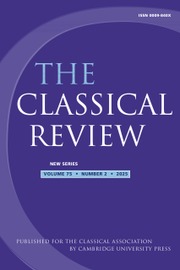The landscape of Cilicia has been extensively researched over the last two decades from archaeological, historical and theological perspectives. C.’s revised 2020 Ph.D. thesis aims to understand Cilicia as a sacred landscape, with the ambitious claim of being the first to examine literary and archaeological material together (p. 266).
The study seeks to investigate the consequences of the construction of martyr shrines and pilgrimage infrastructure in the region, and how local veneration of saints was organised. C. focuses on Cilician holy men and women, their cults and their relationship to the landscape. Another set of questions concerns the connection between the cult of saints and the urban environment. A wide range of topics, such as healing cults, asceticism and virginity, are touched upon.
The volume offers a glimpse into numerous Cilician cities in late antiquity. Each site is presented with its ecclesiastical buildings and most important saints. A brief introduction is followed by 20 chapters dealing with Selinous, Anemourion, Zenonopolis, Coastal Roads, Seleukeia on the Kalykadnos, Alahan, Hasanaliler, Korykion Antron, Korykos, Elaioussa Sebaste, Kanytelleis, Yanıkhan, Pompeioupolis, Tarsos, Mazılık, Akören, Anazarbos, Mopsouhestia and Aigeai. At the end there are a general conclusion, a subject index and 160 colour plates.
The idea of having a fictitious fifth-century pilgrim walk through the book is charming, but partly misleading, especially when he follows paths that historically did not belong to known pilgrimage routes – such as the route from Seleukeia to Diokaisareia in the mountains. Moreover, building structures are necessarily described based on current archaeological evidence, which does not always correspond to the intended travel period of the fictional pilgrim.
By far the largest part of the volume is devoted to descriptions of individual sites. The long and detailed accounts, including unnecessary content (such as the superficial yet lengthy remarks on the missionary journeys of St Paul, pp. 195–8), are tedious to read. Unfortunately, these descriptions contain numerous inaccuracies and errors. This significantly reduces their reliability and usefulness, as seen in the confusion of Justin I with Justinian (p. 44) or misleading topographical details – for example, suggesting a 5.5 km hike through very difficult terrain from the Corycian Cave to Korykos in only 30 minutes (p. 127). Such inaccuracies make it necessary to verify nearly every piece of information independently. For instance, C. cites the metaphrastic Passio BHG 300 as evidence for Korykos, although the text does not mention Korykos or any other specific location. A connection to Korykos can only be inferred by analogy with BHG 299z – an argument C. does not make explicit (pp. 138–9).
On the other hand, the highly complex question of how much historical truth can be derived from hagiographic texts is dealt with in just a few lines (p. 30). In general, C.’s confidence in extracting factual information from martyrdom narratives seems overly optimistic. The narratological perspective (cf. L. Grig, Making Martyrs in Late Antiquity [2004]) is not considered – despite the bibliography listing some relevant titles. Martyrdom accounts are sometimes retold as if they were literal historical reports (e.g. p. 139: ‘But an angel of God came to extinguish the fire, saving the saint once again’, cf. p. 231).
It remains unclear why C. ignores sources and research that contradict her claims, and why she does not clearly indicate when she is engaging in speculation (e.g. p. 219, on the ‘decay’ of Cilician cities). Assertions such as the claim that most roads in Cilicia were renovated under Hadrian are left undocumented (p. 173). Some scholarly findings are misrepresented. For example, C. proposes identifying Bidana with Aydoğmuş (which she refers to as ‘Isaura Nova’) without engaging with the relevant scholarly debate. Her argument is based on a misunderstanding of P. Pilhofer, Das frühe Christentum im kilikisch-isaurischen Bergland (2018), falsely claiming that Pilhofer equated Konon’s home village Bidana and Leontopolis with the modern ruins of Zengibar Kalesi (p. 148). On this basis, she questions how Pilhofer imagines a 40 km torchlight procession took place overnight (p. 149) – a conclusion Pilhofer’s argument does not imply. C. claims the ‘area around Isaura Nova is a rough territory’, which would supposedly fit the text’s description (p. 149), although Aydoğmuş is located in the Lycaonian plain. She places Bidana 3.3 km north of Aydoğmuş, where the landscape is entirely flat.
The writing style at times appears somewhat incongruous (‘The Corycian Cave … vibrates with the power of attraction. The religious buildings … were wrapped in the mysticism of the place’, p. 126). One encounters anachronistic vocabulary such as the term ‘nations’ (‘internationally renowned’, referring to antiquity, p. 269). Technical terms are sometimes used in a non-technical sense (cf. ‘metropolis’ on pp. 157, 218, 283, and elsewhere).
In the conclusion C. outlines the most important pilgrimage routes in and through Cilicia (pp. 269–72). She then attempts to categorise Cilician saints, distinguishing between healers, virgins, missionaries, warriors, patrons and hermits (pp. 273–5). A table on the ‘main features of saints who were born or died in Cilicia’ provides an overview of the most important local saints and their cults (pp. 276–8). A short chapter on ‘Saints and Cities in Late Antique Cilicia’ rightly highlights the importance of saint cults in the urban centres of the time. However, it continues the conceptual vagueness by referring to the cities of Seleukeia, Korykos, Tarsos and Anazarbos as ‘metropoleis’ in a modern sense (pp. 283–6). In a final section nature and historicity are considered as essential elements of religious experience in late antique Cilicia (pp. 287–9).
Readers will find many stimulating ideas. C. poses relevant and interesting questions, though she rarely offers convincing answers. The volume engages with ongoing debates in archaeology, ancient history and cultural studies. It brings together rich, varied and interesting material – but in a speculative, flawed and at times misleading manner, which limits its usefulness as a foundation for further research.


